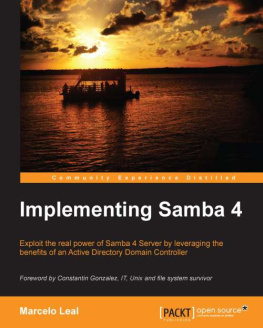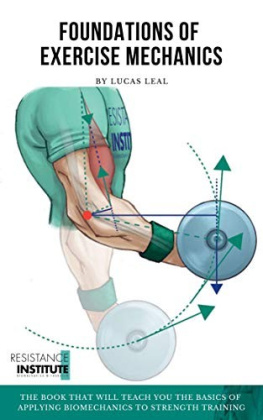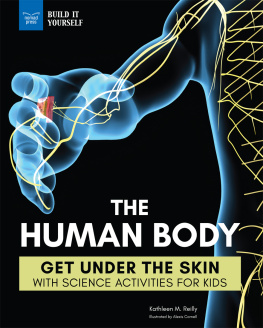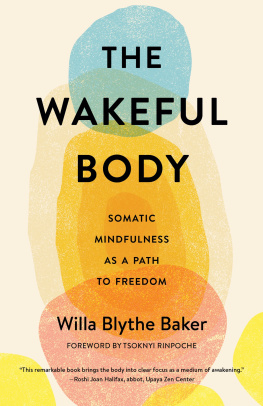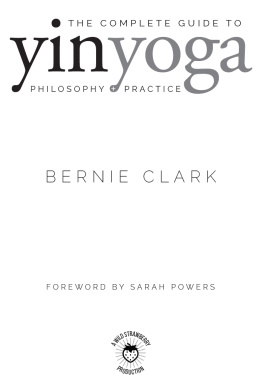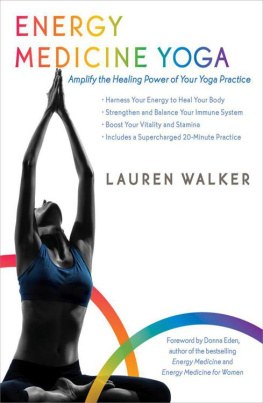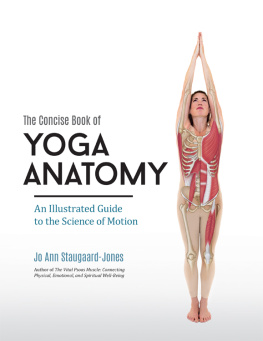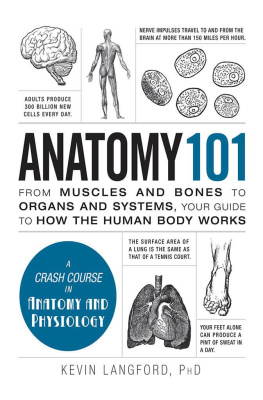Contents
Guide
Page List

To me, the body says what words cannot.
MARTHA GRAHAM
Contents
Introduction
THIS BOOK IS not really an anatomy book. I think of it more like a book about connections. Its funny, but when you ask people to define connections, they often tell you about the times they felt disconnected. These disconnections often remind us that something is amiss. Something is out of balance. Whether it comes from strife in a relationship or an injury to the physical body, the raucous sounds of disharmony wake us up to the beautiful potential of harmony.
As humans, we are a wonderful mess of contradictions. We are incredibly strong yet fragile. All of us look very similarheck, 99.9 percent of our genes are similaryet the teeny differences make a huge difference in how we move through the world. Our bodies are made up of all of these seemingly varied parts, yet they work together like a world-class orchestra tuned to play the most intricate symphony. We are awesomely complex, but as my teacher Rod Stryker likes to tease us when we are getting carried away with ourselves, we are not that interesting or complex.
I still become giddy every time I get the chance to talk to someone about their magnificent form. As a student of the body for more than twenty years, Im still amazed at the hidden gems and the new information that I continue to find. My intent in launching MetaAnatomy was to explore the dynamic beauty and poetry of who you are. The prefix meta-, like in the words metaphysical or metacarpals, means beyond. MetaAnatomy is my attempt to go beyond our often limited view of our own form.
I also really love the idea of meta-analysis, examining the data from many different studies that ask the same question: Who do we think we are? For millennia, humans, whether they are anatomists or yogis, have been creating models and maps to try to answer that very question. I believe that combining our understanding of the physical and energetic anatomies helps us form a richer view and experience of ourselves. My hope is that this combination will bring about a celebration of our differences and, ultimately, an honoring of our connectedness.
Ive subdivided this book into three tasty nuggets. In , The Physical, I introduce you to your physical form, or what I like to call the meat suit. We will do this first by deconstructing all of our bodies bits and bobs, which will give you the anatomical language you need to get to know your meat suit in all of its glory. While I have written these chapters for students and teachers of yoga, I firmly believe that they include information that everyone should know. Please keep in mind that what Im giving you is just an introduction to some of the tissues of the body. In the interest of brevity and comprehension, only certain bones, joints, and muscles have been illuminated. Ive tried to condense what can be the overwhelming topic of human anatomy into fun-size bites. In this attempt, some aspects have been simplified and generalized, but hopefully without diminishing their importance or compromising the accuracy of the information. Each chapter will conclude with a little taste testa small experience or exercise to prompt you to put into practice what you just learned.
In , The Poetic, my intention is to make connections between the physical and energetic anatomies, between systems or schools of yoga, between you and me as we share our embodied experience of being alive in these forms. Starting with different ways to investigate the concept of energy, we will draw correlations between what we can see and what we can experience. Then well take a deep dive into our breath, our nervous system, and the ancient yogic technologies that can have an immediate impact on our physiology. These chapters each include a meditation that will help you turn all the theory into a lived experience.
In , The Practical, well talk about how to bring together all of the information in parts 1 and 2 to make real, lasting, practical changes in our lives as well as in our yoga practice. Ill give you tools you can use to develop X-ray vision! This will allow us to look inside the meat suit and see the unique shape and proportion of your bones and joints so that you can then develop a personal practice that celebrates your uniqueness. Ill also talk about yoga postures and yoga teachers verbal cues that can sometimes be problematic for students. With curiosity and the evolving lens of biomechanics and yoga therapy, we can at least open a discussion about the benefits of these postures and cues and their place in our own practice or teaching. Each of these chapters will include accessible minipractices that can immediately connect you to both your physical and your energetic anatomies.
Where applicable, Ive tried to give a historical context or text when defining certain energetic maps and models. I have done my best to suss out the hotly debated timelines, definitions, and interpretations, but Ill leave it to my more scholarly friends to argue the details. Instead of dissecting and separating the information into different yogic lineages, I find it more interesting to view how cultures, art, schools of thought, and societies have had an effect on the study of both yoga and anatomy, as well as how these factors continue to contribute to their evolution. I have included a lot of Sanskrit, as its definitions have a way of unfolding to expose a treasure trove of understanding. But Ive decided to leave the diacritical marks out of the Sanskrit terms so that we can remain friends.
If you are looking for instructions on how to get into full Lotus or pictures of bikini-clad models performing Chin Stands, sadly, you wont find them in this book. Feel free to use it to even out a wobbly table leg instead. But if youre looking for a practice to maximize your unique potential or if youre looking to teach or practice safe, anatomically meaningful healing sequences that help you explore the more subtle aspects of your energetic, mental, and emotional bodies, which drape your true self like layers of fine silk, my great hope is that you will find it here.
In this book Im sharing what Ive learned from the amazing teachers that Ive been lucky to study with. Im sharing it as I have remembered it and through the lens of my own lived experience. In other words, any praise can go directly to my teachers, and any complaints or disagreements can be forwarded to me.
All my classes and workshops begin with the Sanskrit chant that was given to me by my first teacher:
Guru Brahma
Guru Vishnu
Guru Devo Maheshvarah
Guru Sakshat Param Brahma
Tasmai Shri Gurave Namaha
It is a lovely, profound chant, that I translate as the following: The beginnings are our teacher. The start of something new, coming into a posture and even inhaling are an opportunity to learn the truth of who we are.
The experience of right now, the present moment, can be our teacher. The trials and tribulations, the ups and downs, the sustaining of the breath or posture are all opportunities to understand the truth of who we are.
The endings of things can also be our teacher. The ending of a job or relationship, the exhale, and the coming out of a posture are all opportunities to realize the truth of who we are.
Everyone around you is a teacher who can help to illuminate the truth of who you are.



